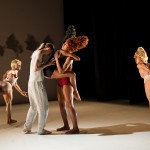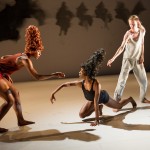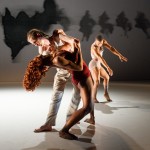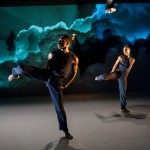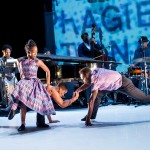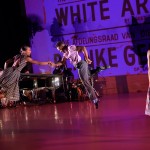Dance Review: Howling Wolf—Abraham.In.Motion at the ICA
One of the reasons audiences and funders love Kyle Abraham’s work is that the layered landscapes of his dances resonate with the fraught conditions outside the theatre.
Kyle Abraham/Abraham.In.Motion—Co-presented by World Music/CRASHarts and the Institute of Contemporary Art at the ICA, Boston.
By Debra Cash
One of the reasons audiences and funders love Kyle Abraham’s work is that the layered landscapes of his dances resonate with the fraught conditions outside the theatre. The four linked dances his splendid troupe, Abraham.In.Motion is now touring—When the Wolves Came In, Hallowed, and The Gettin’ playing now at the ICA, and a fourth, The Watershed, to play MASS MoCA in a co-presentation with Jacob’s Pillow next weekend—address the incomplete struggle for civil rights in South Africa and here at home.
In 2012, Abraham travelled with the Africa Contemporary Arts Consortium and paid his respects at the Hector Pieterson Museum in Soweto, South Africa, named in memory of a 13-year old martyred in an anti-apartheid protest in 1976. The choreographer had been listening to drummer/composer Max Roach’s We Insist!. This juxtaposition became a jumping-off point for a program that Abraham notes “was created to live in a skin well aware of the cyclical hardships of our history.”
- When the Wolves Came In. Photo by Ian Douglas.
- When the Wolves Came In. Photo by Ian Douglas.
- When the Wolves Came In. Photo by Ian Douglas.
Conceptual artist Glenn Ligon literally sets the stage for When the Wolves Came In with art he has described as offering “different levels of legibility.” The screened images on his stunning backdrop seem to be smudged figures in dark hoods standing against the snow but are more likely reverse images of Klansmen. The A.I.M. women (Tamisha Guy, Catherine Ellis Kirk, Penda N’diaye and Connie Shiau) wear bizarre topiary wigs (think Marge Simpson). There’s a Kyrie by Nico Muhly, excerpts from his A Good Understanding, sung by the Los Angeles Master Chorale.
Like the singers’ ardent prayer for mercy, the dancing is unresolved with the dancers’ bodies pulled simultaneously in opposite directions. When an interracial male couple embrace, one partner’s hands shake as if he can’t hold on. At other moments, the dancers’ booty pumping jars against the chorale’s classicism and coexists with it. The dancers’ transformation into wolves is glimpsed in the dropped wrists of the their softened “paws” and later in a lupine, 4-footed walk that is barely domesticated.
- Hallowed. Photo by Ian Douglas.
- Hallowed. Photo by Ian Douglas.
Wolves morphs without pause into Abraham’s Hallowed. Metal work lights drop down. Guy and Kirk help Jeremy “Jae” Neal into fresh clothes. When Bertha Gober begins signing I Told Jesus and Neal begins his solo, it’s impossible not to flash on a young Dudley Williams wanting to be ready in Revelations.
Quickly, though, Neal makes his own statement. With slowly rolling shoulders, he is a man trying to rest more completely in his own skin. When the women join him, their lyrical trio is caught between the projection of clouds and the messy ambient sounds of an energetic Birmingham church service. Balletic grace is cut with touches of pedestrian movement, such as the way they seem to wipe water from their mouths, shake it from their hands, and then dry the hands on their legs. The gestures and the way Abraham has the dancers perform in unison is deeply egalitarian. These are spiritual journeys embarked on in fellowship.
- The Gettin’. Photo by Ian Douglas.
- The Gettin’. Photo by Ian Douglas.
- The Gettin’. Photo by Ian Douglas.
- The Gettin’. Photo by Ian Douglas.
- The Gettin’. Photo by Ian Douglas.
The Gettin’ brings Abraham’s choreography into its most explicit political frame. Composer Robert Glasper’s first major collaboration with a dance company is a triumph. With his jazz trio augmented by vocalist Charenee Wade, the score for The Gettin’ refers back to Max Roach’s righteous anger while charting a contemporary path.
Ligon’s video projection include still images from South Africa such as “Whites Only/Blanke Gebied” signs and a grainy footage of street violence presented in four narrow vertical panels. The famous photograph of the bloodied body of Hector Pieterson could be any young person attacked in Selma in 1964 or in Ferguson today. At one point, two dancers simply stand before the flickering images with their backs to the audience. They are watching, and we have an obligation to watch, too.
Abraham doesn’t shy away from using his dancers’ racial identities for dramatic purpose. A white man (Matthew Baker) and black man (Neil) face off like boxers in opposite corners, broadcasting their power through the deliberate looseness of their swagger and jazzy grapevine steps. Connie Shiau whirls as if unsure which side of the white/nonwhite sign admits her presence. Tamisha Guy does a frantic, collapsing solo before she finds her orientation to the words of a Maya Angelou poem.
Abraham, a brilliant performer, is not dancing during this tour as he addresses some lingering injuries. His current works retain the movement language that developed out of his personal way of moving, including the gyroscope turns, arabesques pulling the dancers backward in space, and hip hop details poking through lucid streams of contemporary modern dance technique.
His presence isn’t necessary. The dancers are that good. It’s worth noting that Kyle Abraham counts them as true collaborators and he has put his money where his mouth is, setting up a royalty system that lasts throughout the lifespan of any given work.
But for longtime admirers of Abrahams’ choreography, including me, the real treat of this tour was the evidence of his increased confidence in shaping tableaux for a large ensemble. Freedom, when it is won, may bring these dancers off balance, but Kyle Abraham sets them on a firm foundation.
Debra Cash has reported, taught and lectured on dance, performing arts, design and cultural policy for print, broadcast and internet media. She regularly presents pre-concert talks, writes program notes and moderates events sponsored by World Music/CRASHarts and cultural venues throughout New England. A former Boston Globe and WBUR dance critic, she is a two-time winner of the Creative Arts Award for poetry from the Hadassah-Brandeis Institute and will return to the 2014 Bates Dance Festival as Scholar in Residence.
c 2014 Debra Cash
Tagged: Glenn Ligon, Institute of Contemporary Art, Kyle Abraham, Nico Muhly, Robert Glasper

